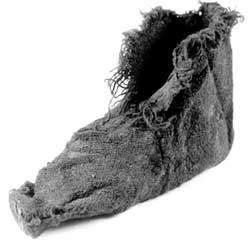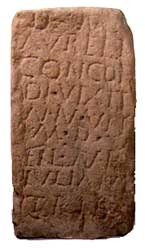| The best known 'character' at Vindolanda
is Flavius Cerialis, prefect of the ninth cohort of Batavians, who
lived with his family in the praetorium at Vindolanda in
the years around AD 100. His correpsondence accounts for over 80
letters of the published and unpublished tablets. We learn little
directly of Cerialis himself, but some things can be guessed of
his likely background. The name Flavius
suggests that he came from a family that gained the citizenship
under Vespasian, perhaps through loyalty to Rome during the Batavian
revolt.
Tablet database link: Browse the correspondence of Cerialis.
The commanders of auxiliary units were required to be of 'equestrian'
rank. This was a high social status that depended on meeting a property
qualification of 400,000 sesterces,
as well as free birth. For some the rank of prefect of an auxiliary
unit might perhaps be the culmination of a military career, for
others greater things beckoned. Brocchus for example, one of Cerialis'
correspondents, probably later commanded a cavalry unit in Pannonia
(Hungary). Other equestrians became senior officers (tribunes) in
a legion.
The governor of Britain is occasionally glimpsed in the tablets.
One letter (248)
implies that Cerialis is soon to meet the governor, in another (225)
Cerialis uses an intermediary to gain access to him. Perhaps a close
personal connection explains the service of troops from Vindolanda
in the governor's bodyguard. The governorship of Britain was a senior
and trusted post because of the size of the garrison, three legions
as well as auxiliary units, a total army of roughly 50,000 men.
The governor had to be of senatorial status, an experienced soldier
and trusted not to use his army to challenge the emperor, a trust
sometimes misplaced.
Tablet database link: Browse the tablets that mention the governor of Britain.
The familia

Click on the image for a larger version.
|
Image
details:
A child's woollen sock, with an upper and
a sole tacked together. Footwear has revealed women and children
as well as soldiers living at Vindolanda.
Image ownership:
© Vindolanda Trust |
The fort prefect was accompanied in his posting by his family,
including his wife and children and the broader familia of
household slaves. The correspondents of Cerialis' wife, Lepidina,
included Claudia Severa, wife of another garrison commander, Aelius
Brocchus, as well as other women (Paterna, Valatta). The reference
to Severa's son in the birthday invitation (291)
reminds us that children lived in the fort as well. Other evidence
for children includes their shoes amongst the leatherwork, and perhaps
the writing exercise (118).
A letter to Cerialis (260)
includes a greeting to the pueri, perhaps Cerialis' slaves.
There are however more certain references to slaves in other officers'
households (301,
347).

Click on the image for a larger version.
|
Image
details:
An inscription commemorating Aurelius Concordius
(RIB 1919).
D(is) M(anibus) / Aureli / Concor / di uixit
/ ann(um) un / um d(ies) V / fil(ius) Aurel(i) / Iuliani /
trib(uni)
'To the spirits of the dead (and) of Aurelius
Concordius: he lived 1 year, 5 days, son of Aurelius Iulianus
tribune.'
Image ownership:
© The Museum of Antiquities of the University and
Society of Antiquaries of Newcastle upon Tyne |
Inscriptions from other northern frontier sites reveal the presence
of family members of the garrison commander. The one year old Aurelius
Concordius, infant son of the tribune at Birdoswald, was commemorated
by his father, Aurelius Iulianus. On a long epitaph, Julia Lucilla
commemorated her husband Rufinus, prefect of the garrison at High
Rochester (of the first two lines only isolated letters survive,
but his name is known from another inscription), listing his offices
and honours (RIB 1288).
to … of the First cohort of Vardulli… prefect of the
1st cohort of Lusitanians, also of the 1st cohort of Breuci, sub-curator
of the Flaminian Way and Doles, sub-curator of public works, Julia
Lucilla, of senatorial rank, (set this up) to her well deserving
husband: he lived 48 years, 6 months, 25 days.
Postings to Britain's northern frontier must at times have been
both dangerous and tedious for families, although glimpses
of birthday parties and festivals suggest another side to life.
Tablet database link: Browse the correspondence of Lepidina, or
the tablets that mention slaves or women.
Soldiers
The tablets also refer to many individuals of lower rank,
junior officers, ordinary soldiers, though we learn little more
about them than we can extract from their names and ranks. The names
for example in 180,
recording the dispensation of wheat, include Macrinus, Felicius
Victor, Spectatus, Amabilis, Crescens, Firmus, Candidus and Lucius,
sound Roman. Some of these individuals may be Italian, but the adoption
of Roman names by non-Roman auxiliary soldiers is a well-known phenomenon.
One such individual is Sabinus Trever (182).
Sabinus is a Roman name but Trever indicates his origin in
another northern Gallic tribe, the Treveri, based around Trier (Augusta
Treverorum) in western Germany. As well as other Latin names (Felicio,
Sanctus), 182
also records several Celtic names, including Atrectus, Exomnius
and Andecarus. 310
gives further examples of Celtic names, Veldeius / Veldedeius and
Velbuteius, and two Germanic names, Chrauttius and Thuttena. Some
Greek names are attested, for example Paris and Corinthus (311).
These might be slaves, who often had Greek names. The diverse cultural
connections suggested by the names illustrate the cosmopolitan culture
of the army.
The Vindolanda tablets allow an insight into the close bonds between
individual soldiers, for example letters between 'messmates' (contubernales)
(310,
311).
We otherwise very rarely hear the voices of ordinary Roman soldiers,
save as stock characters in Roman literature. Study of modern armies
suggest that morale is based on the mutual loyalty of soldiers in
individual units. The Vindolanda letters may then echo one of the
features that made the Roman army an effective fighting force, although
references to deserters suggest morale was not always sustained
(226).
Under Roman law, no soldiers below the rank of centurion were entitled
to be legally married until AD 197. Previously marriages were not
officially recognised but were perhaps nevertheless de facto
unions. Marriage is mentioned in one text (277),
but it is not clear to whom it refers. Perhaps women referred to
in some tablets were soldiers' wives (310).
Footwear and jewellery also indicate the presence of women and children
in forts at this period. If they were permanent residents in the
forts, pressure on space in the cramped barrack
blocks would have been unimaginable. Soldiers perhaps also had
slaves, although no certain examples are identified in the tablets.
Traders
In a small number of cases individuals named in the tablets can
be plausibly identified as civilians. Octavius and Candidus (343),
who correspond concerning the transport of grain and animal hides,
as well as other individuals (192,
207,
344)
were probably civilian traders with a contract for supplying the
army. These negotiatores are better documented on the frontier
zone in continental Europe, where they established themselves through
their involvement in the long-distance movement of goods to the
army along the Rhône and Rhine. Vici outside the frontier
forts perhaps housed such traders, as well as families and dependants
of the soldiers, and veterans, but there is no evidence of the existence
of such a settlement at Vindolanda contemporary with the tablets.
It might have been located in one of the unexplored areas, for example
to the north of the Stanegate road. The visible
remains of the civilian settlement at Vindolanda date to a much
later period.
|